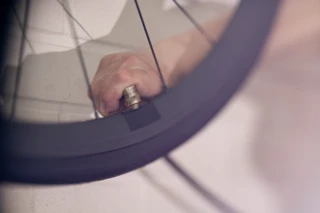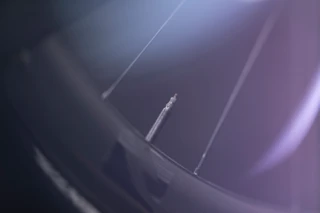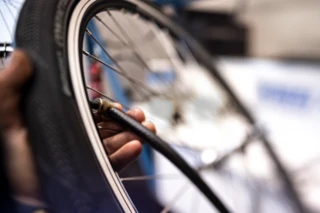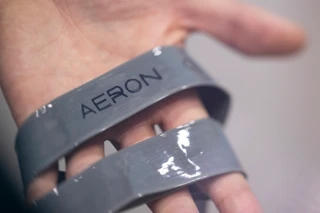Veröffentlicht am
The Right Tire Pressure for Road Bikes
What is the correct or best tire pressure for road bikes? How do changes affect it and what do I need to consider? Here is the guide!

The correct tire pressure is crucial for the performance, comfort, and safety of a road bike and its rider. However, there is no universal guide or general table of values that specify the correct tire pressure. In fact, the correct tire pressure is influenced by many factors, including:
- Rider weight (partly also system weight)
- Tire width
- Rim width
- Terrain
- System (tubeless or tube system)
- Temperature and weather conditions (wetness, heat)
What Makes the Right Tire Pressure?
Tire pressure affects the handling of a road bike in many ways. Too high pressure can worsen handling, increase rolling resistance and the risk of accidents, while too low pressure increases rolling resistance and accelerates tire wear. An optimally adjusted tire pressure, on the other hand, offers the best compromise between rolling resistance, grip, and comfort.
But What is Optimal?
In the past, it was always thought that the more pressure in the tire, the faster. A myth that science and many tests have long since disproved. Not to mention that road bike tires used to be thinner than 20 millimeters. To protect them from punctures and flats, road cyclists often pumped until 11 or even 12 bar could be read on the gauge.
By the way, we are talking about tubular tires on older bikes; not clincher rims with wired or folding tires and a tube, but rims with a flat rim bed on which the tire, where the casing and tube were sewn together, was glued. Anyway, those who had a flat in those old days had to carry a full-length bicycle pump, as some mini pumps of the time were quickly overwhelmed by the demands.
Today, pumps perform much better than before. Very powerful pumps and mini pumps can be found, for example, at Topeak.
How to Measure Tire Pressure on a Road Bike?
The pressure in a road bike tire is the overpressure compared to the ambient pressure, usually given in the unit bar, sometimes also in PSI (pounds per square inch). The conversion: 1 bar = 14.5 psi.
Sometimes it is enough to check the air pressure with a thumb press, whether on a mountain bike (with car valve or Presta valve), road bike, gravel bike, or touring bike. If the tire can be easily pressed in, everything seems fine. A proper air pressure gauge, however, shows minimum and maximum pressure much more precisely and offers you a better chance for more performance, comfort, better handling, and safety.

How Does Rider Weight Affect Tire Pressure on a Road Bike?
The rider's weight plays a crucial role in choosing the right tire pressure. Heavier riders need higher pressures, lighter riders require less. The tires should ultimately spring lightly but not bounce. They should not feel too spongy either. The rider's body weight is largely relevant for the ideal tire pressure. As a helpful approximation, 10 percent of the body weight in bar is considered. If you weigh 75 kilograms, you should pump the tire to 7.5 bar (considering the maximum allowable pressures of tires and rims).
However, you must also consider the system weight, as bikepacking bags with contents can drastically increase the required pressure. Modern tests have shown that wider tires do not roll worse than narrow ones, except perhaps under optimal conditions on a velodrome. Wider rims today allow significantly lower pressure than narrow ones, and the front tire can get a few tenths of a bar less than the rear tire, which carries significantly more load.
By the way, the sidewall of various tires and tire models usually indicates a range from the lowest to the highest recommended pressure.
Can I Undercut the Minimum Pressure on Road Bike Tires?
This question is a bit tricky. Sometimes it can even benefit your performance if you apply less air pressure to the tires than the recommendation on the sidewall of the tire model indicates. For example, if you are riding on a route with a lot of cobblestones and have a correspondingly wide tire. The recommendations printed on the tires are ultimately also intended to protect the tire manufacturer from potential liability claims in the event of a serious accident. So, if you want to inflate less than the recommendation, you should ride more carefully.
How Do Narrower Tires Affect Tire Pressure?
Traditionally – in the old days – narrow tires (23 millimeters or less) were the preferred choice for road cyclists as they promised low rolling resistance. Narrow tires require higher pressure to achieve the same rolling resistance as wider tires. Typically, the recommended pressure for 23-millimetre tires is between 7 to 8 bar (100 and 120 psi).

And What About Wider Tires?
In recent years, there has been a trend towards wider tires (25 millimeters and more). These offer a larger contact area, which increases comfort and improves traction, especially on uneven surfaces. At the classic race Paris – Roubaix, most professionals now ride tires between 28 and 30 millimeters wide, some of them tubeless. The advantage: wider tires can be ridden at lower pressures without increasing rolling resistance. The comfort for the riders increases immensely with the wider tires, and ultimately improves their performance.
How Do Good Roads Affect the Choice of Tire Pressure?
On smooth, paved roads, higher tire pressure can be used as rolling resistance is minimized and speed maximized. Here, the traditional recommendations of 7 to 8 bar (100 to 120 psi) for narrow tires apply.
Speaking of Rolling Resistance: What is it Actually?
Rolling resistance is the force that opposes a rolling wheel or tire and slows its movement. This force mainly arises from the deformation of the tire on the road surface and the internal friction forces within the tire itself. This leads to energy losses that the rider has to compensate for with muscle power. The faster you ride, the harder you have to pedal to overcome rolling resistance. High tire pressure reduces rolling resistance but also decreases comfort. Since asphalt in normal road traffic is not particularly smooth, unlike in a velodrome, too high tire pressure results in a bumpy ride. The tire bounces and vibrates easily. On uneven roads and cobblestones, it is therefore better to reduce tire pressure. Lower pressure allows the tire to adapt better to the surface, increasing comfort and improving control. Here, road cyclists can choose pressures from 4.8 to 6.2 bar (70 to 90 psi), depending on tire width and rider weight.
How Does Rim Width Affect Tire Pressure on a Road Bike?
Rim width affects the shape of the inflated tire, air resistance, and tire pressure. Wider rims allow for wider tires. A wider rim with a wider tire requires less air pressure to achieve the same performance. For example, a 25-millimeter tire on a wide rim can have the same rolling resistance at only 5.5 bar (80 psi) as at 6.2 bar (90 psi) on a narrower rim. The comfort is significantly greater with the wider rim.
Comparing Tubeless Systems to Tube Tires
Tubeless systems are becoming increasingly popular as they offer several advantages, including lower risk of punctures and the ability to ride at lower pressures without the risk of pinch flats (snake bites). The recommended pressure for tubeless tires is usually about 0.7 to 1 bar (10 to 15 psi) lower than that of tube systems.
What to Consider When Riding TPU Tubes on a Road Bike?
TPU tubes, such as AERON/TPU Airtubes, are generally ridden with similar air pressures as butyl tubes. However, the puncture protection – both against punctures and pinch flats (snake bites) – is higher compared to butyl tubes, which allows more flexibility in choosing tire pressure. Another advantage is the lower rolling resistance caused by TPU tubes. As mentioned earlier in the article, rolling resistance is partly due to the friction between the tube and the tire; this is significantly lower with AERON/TPU Airtubes than with conventional butyl bicycle tubes.

While We're at It, What are the Advantages of TPU Tubes?
Compared to butyl rubber tubes, TPU bicycle tubes have many advantages. They are:
- More puncture-resistant (high reliability in any terrain and conditions; better protection against pinch flats and punctures)
- Smaller (fits in any jersey pocket)
- More airtight (cyclists need to pump less often)
- Lighter (their weight is on average 60 percent less than butyl, regardless of the bike type)
Below you will find a table with general recommendations for tire pressure, based on tire width, rider weight, and system type:
| Rider Weight | Tire Width | Tubeless System | Tube System |
|---|---|---|---|
| 60-70 kg | 25 mm | 70-80 psi (4,8-5,5 bar) | 80-90 psi (5,5-6,2 bar) |
| 60-70 kg | 28 mm | 60-70 psi (4,1-4,8 bar) | 70-80 psi (4,8-5,5 bar) |
| 70-80 kg | 25 mm | 75-85 psi (5,2-5,9 bar) | 85-95 psi (5,9-6,6 bar) |
| 70-80 kg | 28 mm | 65-75 psi (4,5-5,2 bar) | 75-85 psi (5,2-5,9 bar) |
| 80-90 kg | 25 mm | 80-90 psi (5,5-6,2 bar) | 90-100 psi (6,2-6,9 bar) |
| 80-90 kg | 28 mm | 70-80 psi (4,8-5,5 bar) | 80-90 psi (5,5-6,2 bar) |
| 90-100 kg | 25 mm | 85-95 psi (5,9-6,6 bar) | 95-105 psi (6,6-7,2 bar) |
| 90-100 kg | 28 mm | 75-85 psi (5,2-5,9 bar) | 85-95 psi (5,9-6,6 bar) |
A SUMMARY: Choosing the right tire pressure for road bikes depends on factors such as tire width, terrain, rim width, as well as the rider's weight and the tire system used. It is important to consider these aspects to ensure optimal performance, comfort, and safety. By testing and adjusting the tire pressure to individual needs and conditions, you can get the best performance out of yourself and your road bike.